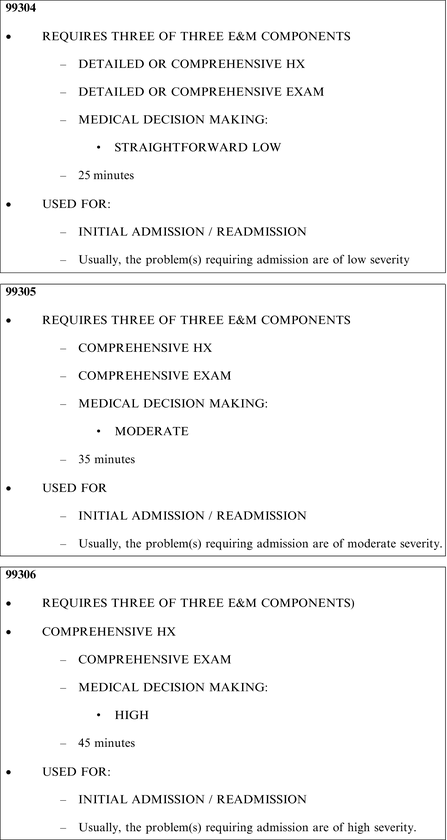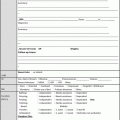Fig. 1
Glossary of terms
Documenting the Visit
The AMA is responsible for establishing and maintaining the CPT codes. The AMA defined documentation guidelines for Evaluation and Management (E/M) codes in 1995 and these were revised in 1997. These are available on the CMS website. Either set can be used but one cannot mix the guidelines for any one encounter, except that, starting September 10, 2013, physician’s using the 1995 guidelines may use the 1997 definition of Extended History along with the other elements of the 1995 guidelines. AMDA has issued a Guide to Long Term Care Coding, Reimbursement and Documentation based upon the AMA’s CPT guide (available for ordering at www.amda.com).
There are seven components that define provider encounters. In most cases the first three are called the Key components and are used to define the level of E/M service.
History
Physical examination
Medical decision making
Patient counseling
Coordination of care
Severity of the presenting problem and
Time or duration needed to render the service
The three Key Components each has four levels of extensiveness or complexity.
History
The four types of history and their definitions are as follows:
Problem focused: brief history of present illness or problem
Expanded problem focused: brief history of present illness: problem pertinent system review
Detailed: extended history of present illness; problem pertinent review of systems; pertinent past, family and/or social history directly related to patient’s problems
Comprehensive: extended history of present illness; review of systems that is directly related to the problem(s) indentified in the history of the present illness plus a review of all additional body systems; complete past, family and social history.
A Chief complaint is needed for each encounter.
Examination
The four types of physical examination are defined as follows:
Problem focused: A limited examination of the affected body area or organ system.
Expanded problem focused: A limited examination of the affected body area or organ system and other symptomatic or related body area(s) or organ system(s).
Detailed: An extended examination of the affected body area(s) and other symptomatic or related body area(s) or organ system(s).
Comprehensive: A general multisystem examination or a complete examination of a single organ system and other symptomatic or related body area(s) or organ system(s).
Medical Decision Making
The four types of medical decision-making are based on:
The number of possible diagnoses
The number of management options that are considered
The amount and complexity of medical records and other information that must be reviewed
The risk of significant complications, i.e., morbidity and/or mortality, in addition to comorbidities and their respective severity and how all these can impact management options
The four levels of complexity of medical decision-making are as follows:
Straightforward: minimal number of diagnoses or management options; minimal or no data to be reviewed; minimal risk of complications, morbidity, and mortality.
Low complexity : limited number of diagnoses or management options; limited amount or complexity of data to be reviewed: low risk of complications, morbidity, and mortality.
Moderate complexity: multiple diagnoses or management options: moderate amount of complexity of data to be reviewed: moderate risk of complication, morbidity, and mortality.
High complexity: extensive diagnoses or management options; extensive amount or complexity of data to be reviewed; high risk of complication, morbidity, and mortality.
Time
Time can be used to define a level of E/M service if counseling and coordination of care predominates the encounter (>50 % of time spent). Time is also used for prolonged service codes (see below). Otherwise the times associated with the E/M codes are not used to define the level of service provided and are to be only used as estimates. Document time spent with the patient in conjunction with the medical decision-making involved and a description of the coordination of care or counseling provided. Documentation must be in sufficient detail to support the claim.
Coding and Billing for Nursing Facilities
The E&M service code selection is based upon fulfilling the requirements of the individual CPT codes as well as fulfilling medical necessity requirements. Having provided the service and properly documented the care, the selection of the most accurate CPT code is relatively straightforward.
Skilled Nursing and Nursing Facility Visits
For attending physician services, there are four groups of service codes:
Initial Nursing Facility Care (services provided on admission to the SNF or NF for the initial comprehensive assessment): 99304, 99305, 99306. The patient’s attending physician of record must append the modifier “AI” to the bill when performing initial visits.
Subsequent Nursing Facility Care (services provided subsequent to or prior to the initial comprehensive assessment): 99307, 99308, 99309, 99310.
Services provided for discharge: 99315 or 99316.
Services provided for annual health evaluation: 99318.
Note that all codes apply to either new or established patients.
The appropriate Initial Nursing Facility Care code is determined by the extensiveness and complexity of the components of the E/M service provided: with the most comprehensive service being billed at level 99306 (see Fig. 2). All the initial codes require that all three E/M components be performed (history, physical, medical decision making). These codes are used for the initial admission (or readmission, if the patient has previously resided in the nursing facility and had been discharged, i.e., no bed hold). The Subsequent Nursing Facility care codes are reviewed in Fig. 3. Again, the appropriate subsequent care code is determined by the complexity of the components of the E/M service provided, with the most complex and comprehensive services being coded at the 99310 level.







